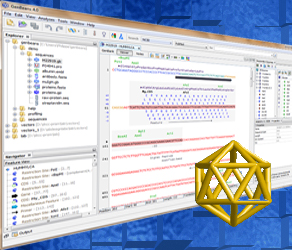ADVERTISEMENT
Protein Patterns & Motifs
Patterns & Motifs Search
The ELM Server is a resource for predicting functional sites described by the Eukaryotic Linear Motif database in eukaryotic proteins.
Scansite searches for motifs within proteins that are likely to be phosphorylated by specific protein kinases or bind to domains such as SH2 domains, 14-3-3 domains or PDZ domains.
PROSITE Scan compares a protein sequence against the signatures in PROSITE.
Bioware webserver contains several tools for short linear motif discovery and peptide characterisation and related analysis of proteomics data. The tools are hosted by the Shields' Lab, Conway Institute of Biomolecular and Biomedical Research and Complex and Adaptive Systems Laboratory, in University College Dublin:
- CompariMotif: for simple motif comparisons.
- SAAMCO: finds small molecules resembling peptides based on their side chains.
- Gopher: generates alignments of orthologous proteins
- SLiMFinder: identifies short linear motifs in a group of proteins
- SLiMPrints: finds cohorts of locally conserved residues
- SLiMSearch: finds regular expression matches in protein sequences
- CycloPs: generates structures for and displays properties of cyclised and linear peptides
- PeptideLocator: identifies bioactive peptides in protein sequences
- SLiMPred: identifies potential SLiM-like regions in a protein sequence
- PeptideRanker: ranks peptide(s) by the predicted probability that the peptide will be bioactive
- EpiC: Antigenicity and functional prediction of proteins
PRINTS is a compendium of protein fingerprints. A fingerprint is a group of conserved motifs used to characterise a protein family; its diagnostic power is refined by iterative scanning of a SWISS-PROT/TrEMBL composite. Usually the motifs do not overlap, but are separated along a sequence, though they may be contiguous in 3D-space. Fingerprints can encode protein folds and functionalities more flexibly and powerfully than can single motifs, full diagnostic potency deriving from the mutual context provided by motif neighbours.
Search against FingerPRINTScan with a protein query sequence to identify the closest matching PRINTS sequence motif fingerprints in a protein sequence.
This tool allows the user to search for patterns conserved in sets of unaligned protein sequences. The user can specify what kind of patterns should be searched for, and how many sequences should match a pattern to be reported.
PRATT is a tool to discover patterns that are conserved in a set of protein sequences. The patterns are reported using the PROSITE format.
Sequence Pattern Discovery generates patterns from a collection of unaligned protein or DNA sequences
Motif scanning means finding all known motifs that occur in a sequence. This form lets you paste a protein sequence, select the collections of motifs to scan for, and launch the search.
Relationships between protein sequences and motifs. Hits is a free database devoted to protein domains. It is also a collection of tools for the investigation of the relationships between protein sequences and motifs described on them. These motifs are defined by an heterogeneous collection of predictors, which currently includes regular expressions, generalized profiles and hidden Markov models.
Minimotif Miner (MnM) analyzes protein queries for the presence of short functional motifs that, in at least one protein, has been demonstrated to be involved in posttranslational modifications, binding to other proteins, nucleic acids, or small molecules, or proteins trafficking.
The Nine Amino Acid Transactivation Domain (9aaTAD) describes a nine amino acid-long motif that is common to the transactivation domains of many transcription factors ranging from Gal4 to p53 to NF-?B.
PATTINPROT is a tool to scan a protein database of one or several sequences for one or several patterns.
Protein Repeats
RADAR (Rapid Automatic Detection and Alignment of Repeats in protein sequences) identifies gapped approximate repeats and complex repeat architectures involving many different types of repeats.
De novo tandem repeat detection and architecture modeling in protein sequences
TRUST is a method for ab-initio determination of internal repeats in proteins.
REPRO is able to recognise distant repeats in a single query sequence.
Low Complexity Regions
Protease & Cleavage Sites
Predicts potential protease and cleavage sites and sites cleaved by chemicals in a given protein sequence
The cleavage specificities of selected enzymes and chemicals.
Calculate masses of peptides and their post-translational modifications for a UniProtKB/Swiss-Prot or UniProtKB/TrEMBL entry or for a user sequence
Protein proteolytic enzyme or reagent cleavage digest.
CutDB focuses on the annotation of individual proteolytic events, both actual and predicted.
ProP 1.0 server predicts arginine and lysine propeptide cleavage sites in eukaryotic protein sequences using an ensemble of neural networks. Furin-specific prediction is the default. It is also possible to perform a general proprotein convertase (PC) prediction.
The NetPicoRNA World Wide Web server produces neural network predictions of cleavage sites of picornaviral proteases.
NetCorona predicts coronavirus 3C-like proteinase (or protease) cleavage sites using artificial neural networks on amino acid sequences.
The Web Bench
The Web Bench
is the essential companion to the biologist, bringing informational resources and a collection of tools & calculators to facilitate work at the bench and analysis of biological data.
Check out the full online bench here
Check out the full online bench here
Sequence Analysis with GenBeans
 Try GenBeans: Best free software for DNA sequence editing!
Try GenBeans: Best free software for DNA sequence editing!
FEEDBACK
Your comments & your suggestionsare appreciated. Please, notify us for resources and tools that you would like to see on this bench!





